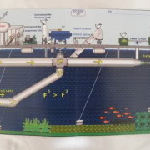 Mark Johnson Jun 17, 2014 03:14 |
Hello Cyclonebuster. With the earth being 70% water and oceans producing galactic kinetic energy numbers, the Tunnel is for sure plausible. The Tunnel structure, its alignment with changing current directions, its dimensions, energy transmission schema and avoidance of subsurface devices/vessels are key thoughts.
Using "Eddy Current Flux/Electromagnetic" energy represents real potential. Here are some thoughts on this (note the authors cover additional oceans/currents describing eddy flux prominence):
http://www.whoi.edu/main/technology-transfer
http://journals.ametsoc.org/doi/abs/10.1175/1520-0485%282003%29033%3C1182%3AFOOTSO%3E2.0.CO%3B2
Suggest you reach out to the premier institution Woods Hole (WH).
WH has a technology transfer division and they are open to discussing your ideas:
http://www.whoi.edu/main/technology-transfer
Good Luck and thank you. Mark
|
 Patrick Mcnulty Jun 17, 2014 04:08 | Proposal contributor
Thanks Mark.... Perhaps MIT and Woods Hole combined can help model my idea... Will send them this way if possible or if interested and please don't forget to click Support Proposal ICON in top right corner..
|
 Mark Johnson Jun 17, 2014 10:38 |
Within about 60 seconds+, Woods Hole will be able to peak their internal interest about your project. I believe Woods Hole is #1 in the world. So your project purpose and intellect are worthy of a Woods Hole assessment. Good Luck, I think Woods Hole will leverage your efforts. My fingers are crossed! Mark
|
 Patrick Mcnulty Jun 19, 2014 04:51 | Proposal contributor
Well I am posting this link on their Facebook page. Let's see if they are interested..
|
 Romalino Caraig Jun 20, 2014 10:49 |
Hi team,
Are the same principles as that of harnessing tidal energy at work? I think this is great and innovative. However, I got quite confused with the method of implementation. Could you kindly provide a more detailed course of action (i.e., what structures need to be installed, how is the energy supposed to be converted from one form to another, how this might impact coastal communities, etc.)?
Let me know how I could help.
Regards,
Romalino
|
 Patrick Mcnulty Jun 20, 2014 12:51 | Proposal contributor
Hi Romalino, "Are the same principles as that of harnessing tidal energy at work?" Very good analogy I would say pretty much so.. Need to build attachment points on the sea floor that the cables are attached to to hold it against the opposing flow of the Gulfstream... There are two methods of power generation at work simultaneously one being kinetic for the turbine generator extracting the energy from the flow of the water thru the venturi. The other method is converting the thermal energy of the ocean water near the surface to make electrical power otherwise known as ocean thermal energy conversion... http://en.wikipedia.org/wiki/Ocean_thermal_energy_conversion Hope that helps some....
|
 Patrick Mcnulty Jun 20, 2014 12:38 | Proposal contributor
Also, " how this might impact coastal communities ,etc".. I listed some of the effects under the list of benefits in the proposal.
What are other key benefits?
I study the idea daily and have found the idea can reverse many of the ill effects of climate change that fossil fuels are bringing us today such as Co2. SOX, NOX, particulate matter, smog, higher sea levels, higher sea surface temperatures, red tide,hypoxic oceans, lower PH levels in our oceans, coral bleaching, loss of Northern summertime arctic ice, Loss of the Antarctic Ice shelf, loss of albedo, skin cancer,Loss of Methane Hydrates, Melt of Arctic Tundra, lung cancer, war, heart attacks, stroke, asthma, loss of polar bears, sea lions, narwhals, walrus, krill, shrimp, rain forest's, soil moisture, more desertification and prevents fracking. etc. etc. etc. They can also weaken a category 5 hurricane such as hurricane Andrew to a category 2 or 3 storm prior to landfall by lowering SST's to ~70 degrees F 3 days prior to it's arrival if needed...
|
 Jessica Thompson Jun 20, 2014 07:34 |
Hello Cyclone, The idea as expressed in a phrase or two is interesting but the proposal would be strengthened by a more detailed explanation of the technology, business plan, feasibility concerns, financing etcetera.
Best,
Jessica
|
 Patrick Mcnulty Jun 20, 2014 07:50 | Proposal contributor
Hi Jessica are you familiar with ocean thermal energy conversion technology?
|
 Nanda Kumar Janardhanan Jul 19, 2014 10:01 |
Please look into the structure of the proposal. Add a bit more information into the summary and other sections to ensure that this proposal draws attention of readers.
|
 Patrick Mcnulty Jul 19, 2014 12:53 | Proposal contributor
Hi Nanda, I was going to do that but the summary section doesn't have enough text space for me to covey my thoughts. So I added links that explain them and what they can do to change climate to get us to 300 - 350 ppm Co2 In 20 years...... They are explained a bit more further down in the proposal.
|
 Climate Colab Aug 13, 2014 04:20 |
Your proposal, well innovative and interesting, suffering from a lack of details on the proposal page itself. Instead readers were asked to follow a number of links to sites and videos, which while potentially useful, decreases the ability for someone to quickly review the proposal. As well, there were information gaps in terms of costing and implementation and what information was provided raised questions about the practical viability of the project. We would encourage you to further flesh-out this proposal for future contests and to present it in a more succinct and informative fashion. Perhaps describing a pilot project that could be developed with estimated costing and timelines provided? Thanks again and we do hope that you continue to to be involved with the Climate CoLab community.
|
